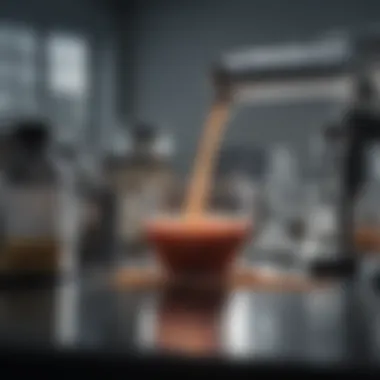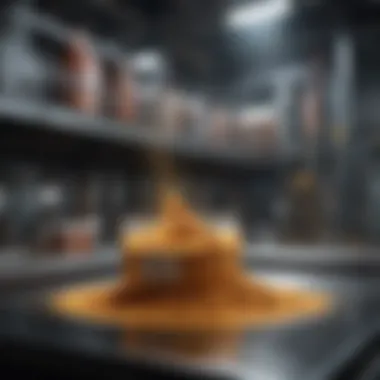Exploring the Impact and Uses of Scientific Powder


Intro
Scientific powder represents a crucial material in various fields, from academia to industry. Its unique properties grant it diverse applications that range from pharmaceuticals to manufacturing processes. Understanding the multifaceted roles of scientific powder not only sheds light on its importance but also highlights the need for a comprehensive examination of its implications and challenges.
The intricate balance between different types of scientific powder, the methods of preparation, and the associated safety considerations forms the core of this article. This narrative is designed for students, researchers, educators, and professionals, intending to provide an in-depth exploration of how scientific powder influences various disciplines.
Research Overview
Summary of Key Findings
The investigation into scientific powder yields several critical insights. First, its applications span multiple domains, including engineering, medicine, and environmental science. Scientific powder contributes to drug formulation, additive manufacturing, and even analytical applications in laboratories. Additionally, the article identifies key types of scientific powder, such as metallic, ceramic, and polymer powders, each serving a distinct purpose.
Secondly, preparation methods, including milling and granulation, play a significant role in determining the characteristics of the final product. This affects not only performance but also safety and environmental impact.
Relevance to Current Scientific Discussions
In an era where innovation is at the forefront of scientific research, the role of scientific powder cannot be understated. Current discussions in material science increasingly focus on how these powders can contribute to sustainable practices. The exploration of biodegradable powders or those made from recycled materials aligns with global efforts towards sustainability.
Furthermore, by bridging theoretical concepts with practical applications, this article addresses how scientific powder remains relevant in ongoing research endeavors. A deeper understanding of its implications can guide future innovations and help navigate the challenges presented by evolving demands.
Methodology
Research Design and Approach
The research design for this article relies on a systematic review of literature pertaining to scientific powder. This encompasses peer-reviewed journals, industry publications, and contemporary studies that offer insights into its applications. Through this approach, a foundation is laid for understanding both historical context and emerging trends within the field.
Data Collection and Analysis Techniques
Data collection involves gathering quantitative and qualitative data. Surveys and interviews with professionals in the field can provide firsthand accounts of how scientific powders are utilized. Additionally, statistical analysis of the properties and functionalities of various powders supports the claims presented in this article. By analyzing existing data and integrating primary research, a comprehensive overview of the topic is achieved.
"Scientific powder qualifies as a key element not just in conventional manufacturing, but also in revolutionary practices across industries. Its impact is profound and far-reaching."
Prologue to Scientific Powder
The exploration of scientific powder is essential for understanding its varied roles in numerous fields, including research, industry, and everyday life. Scientific powders serve as foundational materials in countless applications, highlighting their versatility and importance. Recognizing the significance of these powders can lead to innovations that enhance product performance and efficacy.
Defining Scientific Powder
Scientific powder refers to finely divided solid materials that can be composed of organic or inorganic substances. These powders possess unique properties, such as high surface area and reactivity. Typically, scientific powders are produced through processes like milling or spray drying, resulting in particles that can range in size from nanometers to micrometers. This fine granularity allows for controlled application in various sectors, including pharmaceuticals, food technology, and nanotechnology.
Historical Development
The history of scientific powder is expansive, tracing back to ancient practices in metallurgy and medicine. Early civilizations utilized powders for medicinal purposes and as pigments in art. The advancement of chemistry in the 18th and 19th centuries further propelled the understanding of powder behaviors. The development of techniques for particle size reduction, such as milling and crystallization, has significantly enhanced the utility of powders. In the modern era, scientific powders are integral to advanced manufacturing and material science, representing a crucial link between historical techniques and contemporary applications.
Types of Scientific Powder
Understanding the different types of scientific powder is crucial for both theoretical and practical applications across various fields. This classification serves to highlight the diverse compositions and functionalities of these powders, each offering unique benefits and considerations. As industries and research continue to evolve, knowing the specific characteristics of organic, inorganic, and composite powders becomes increasingly important for maximizing efficiency and enhancing outcomes.
Organic Powders
Organic powders are derived from natural sources, often involving plant or animal matter. They are rich in carbon-based compounds and are widely used in several applications, from pharmaceuticals to food technology. One significant advantage of organic powders is their biocompatibility. This makes them suitable for medical formulations and nutraceuticals.
In the context of drug delivery, organic powders can enhance the solubility and absorption of active ingredients. They facilitate controlled release, which is ideal for providing a sustained effect without overwhelming the body's systems.


Common examples of organic powders include:
- Herbal extracts: Used for their therapeutic qualities.
- Sugars: Involved in food and beverage formulations.
- Proteins: Used in dietary supplements and food products.
Despite these advantages, there are challenges. Organic powders can be susceptible to degradation through factors such as heat or moisture. Hence, storage and handling practices must be strict to maintain integrity and efficacy.
Inorganic Powders
Inorganic powders are composed primarily of minerals or synthetic substances. They are distinguished by their defined chemical structure and stability at various temperatures and environments. In various industries, the unique properties of inorganic powders play a vital role in applications ranging from electronic tools to construction materials.
For instance, in pharmaceutical manufacturing, inorganic powders like calcium carbonate or magnesium silicate are often utilized as excipients that aid in the formulation of tablets and capsules.
Here are some typical applications of inorganic powders:
- Ceramics: Used for creating robust materials in engineering.
- Catalysts: Enhance chemical reactions in industrial processes.
- Nanoparticles: Applied in advanced materials for electronics and medicine.
However, inorganic powders also present their own hazards. They may pose risks through inhalation or may cause irritation during handling, thus requiring careful management of safety protocols.
Composite Powders
Composite powders are a combination of both organic and inorganic materials, engineered to enhance performance and functionality. The significance of composite powders lies in their ability to leverage the benefits of each component while mitigating disadvantages. This can result in enhanced physical properties like strength, flexibility, and thermal resistance.
In applications such as additive manufacturing, composite powders are critical as they allow for creating advanced structures with specific mechanical and thermal properties. For instance, using polymers combined with ceramic powders has proven advantageous in producing components for aerospace applications.
Key considerations regarding composite powders include:
- Versatility: They can be tailored for specific applications by adjusting the ratios of components.
- Performance: Often provide improved outcomes over single-component powders in terms of durability and efficiency.
- Cost: While they may offer better performance, the cost of production can be higher than using standard powders.
In summary, each type of scientific powder holds its own characteristics that are essential for various applications and industries. Being aware of the specific types and their implications aids researchers and professionals in making informed decisions regarding material selection and use, ultimately leading to enhanced innovation and effectiveness.
Applications of Scientific Powder
The applications of scientific powder are vast and impact various sectors. Scientific powders serve multiple functions, ranging from basic research tools to significant components in industrial manufacturing. Understanding these applications is crucial for appreciating the role of scientific powder in modern society. Each application can offer distinct benefits, such as enhanced precision in experiments or improved product formulations. As industries continue to evolve, the demand for innovative powder applications becomes more relevant.
In Research
Scientific powders are essential in laboratories for both basic and applied research. They facilitate multiple processes, including drug formulation, material characterization, and environmental analysis. Researchers rely on powders for their ability to provide specific surface area and reactivity, particularly in chemistry and materials science. For example, researchers often utilize metal powders in nanoscale synthesis, leading to innovations in nanotechnology. The high surface area of powders often leads to faster reaction rates, enabling researchers to conduct experiments more efficiently.
In Industry
In various industries, scientific powders have transformed production processes. Their versatility allows for a broad range of uses in manufacturing sectors that require precision and consistency.
Pharmaceutical Manufacturing
In the pharmaceutical industry, scientific powders are fundamental in producing medications. Active pharmaceutical ingredients (APIs) often exist in powdered form. This form facilitates easier manipulation during production. For instance, the ability to mill substances to a specific particle size can greatly affect bioavailability. One key characteristic of powder formulation is its scalability, which means it can be adjusted for larger batches without losing efficacy. This attribute makes it a beneficial choice for the production of various drug types. However, challenges like uniformity in particle size and ensuring the stability of sensitive compounds must be carefully monitored.
Cosmetic Products
The cosmetic industry also relies heavily on scientific powders. Many makeup products, such as foundation or eyeshadow, are created using powdered ingredients. These powders provide texture and coverage, enhancing product performance. A key characteristic of cosmetic powders is their ability to be easily blended into formulations. This blendability allows for a seamless application and is appealing for both manufacturers and consumers. However, concerns about the compatibility of powders with skin types must be evaluated, as certain ingredients can lead to allergic reactions.
Food Technology
In food technology, scientific powders play a crucial role in enhancing food products. From flavoring agents to nutrients, powders are integral to food formulation. One significant advantage of using powdered ingredients is their extended shelf life. Drying processes often preserve the aromas and flavors much better than liquid forms. An example is dehydrated fruits, which retain substantial nutritional content. However, challenges exist due to potential loss of texture and flavor when powders rehydrate.
In Daily Life


Scientific powders find their way into numerous products that we use daily. From cleaning agents to food additives, these powders are ubiquitous. Their ability to dissolve, blend, or react with other ingredients makes them indispensable in many consumer goods. Individuals often overlook this significance, but many daily conveniences and necessities depend on these fine particles. The efficient use of scientific powders enhances not only performance but also overall user satisfaction in everyday products.
Preparation of Scientific Powder
The preparation of scientific powder is a critical aspect of its applications across various fields. Understanding this process helps in controlling the characteristics of the final product, which can affect efficacy and usability. Factors such as particle size, morphology, and surface area play essential roles in how these powders perform in different environments, whether it be in pharmaceuticals or materials science. Preparation methods can determine the quality and functionality of the powders produced, making meticulous attention to detail necessary.
Milling Techniques
Milling is one of the most common methods used to produce scientific powders. This method involves the mechanical reduction of particle size. It can be performed in different ways, including ball milling, jet milling, and hammer milling. Each method presents unique advantages and considerations.
- Ball Milling: Involves the use of heavy balls to crush and grind materials into finer powders. It is particularly useful for materials that need to be reduced to a nano-size level.
- Jet Milling: This technique uses high-speed jets of air to create friction and impact, producing very fine powders. It is known for its ability to achieve a narrow particle size distribution.
- Hammer Milling: Employs high-speed rotating hammers to shred materials into smaller particles. This method is more effective for larger feed materials, but it may create more heat and moisture sensitivity.
The choice of milling technique is often dependent on the specific properties required for the powder being produced. Optimizing this process can lead to better product performance in its intended application.
Spray Drying Processes
Spray drying is another important preparation method that converts a liquid solution into a dry powder. This is achieved by spraying the liquid feed into a hot gas stream. As the liquid evaporates, fine particles are formed. This method is widely used in industries like pharmaceuticals and food technology.
Key benefits of spray drying include:
- Uniform Particle Size: This process can create powders with controlled size and shape, which is important for consistency in applications.
- Preservation of Characteristics: It helps retain the bioactive properties of sensitive materials, particularly those found in pharmaceuticals or food products.
- Continuous Process: Unlike batch-wise methods, spray drying can be operated continuously, enhancing efficiency.
Despite its advantages, there are challenges associated with spray drying, such as the need to control the drying speed to prevent clumping or degradation of the product.
Freeze Drying Methods
Freeze drying, or lyophilization, is a method used to remove moisture from a material, particularly sensitive compounds. The process involves freezing the substance and then reducing the surrounding pressure to allow the frozen water in the material to sublimate directly from solid to gas. This technique is especially popular for preserving biological or pharmaceutical products.
The main advantages of freeze drying include:
- Preservation of Structure: Since materials are frozen before drying, their structure remains intact, which is critical for biological samples.
- Extended Shelf Life: Removing moisture helps prevent the growth of microorganisms, thus prolonging the powder's viability.
- Enhanced Solubility: Freeze-dried powders often rehydrate quickly, making them desirable for pharmaceutical applications.
However, freeze drying can be costly and time-consuming. It requires specialized equipment and tight control over parameters such as temperature and pressure.
Safety and Handling of Scientific Powder
Handling scientific powder involves careful consideration of potential hazards and necessary precautions. This topic is vital in ensuring not only the safety of individuals but also the integrity of scientific research. Improper handling of powdered substances can lead to accidents, exposure to toxic materials, or contamination in experiments. Therefore, understanding the risks and the proper methods for managing these materials is crucial.
Hazards Associated with Powdered Substances
Powdered substances, even those considered harmless in larger forms, can present significant hazards when reduced to a fine powder. Common risks include:
- Inhalation Hazards: Many powders can release harmful particles into the air. Breathing these particles can lead to respiratory issues. For example, fine silica dust is known to cause silicosis, a severe lung disease.
- Chemical Reactivity: Some powders may react violently when mixed with water or other chemicals. This is crucial in industries that utilize reactive materials, like those dealing with certain metal powders or organometallic compounds.
- Dust Explosions: Accumulated dust in a confined space can create an explosive atmosphere. Such events can be disastrous, especially in industrial settings where large quantities of powders are involved.
Personal Protective Equipment
Using appropriate personal protective equipment (PPE) is one of the best ways to mitigate risks associated with powdered substances. Essential PPE includes:
- Respirators: To prevent inhalation of harmful particles, respirators equipped with appropriate filters should be worn in environments with airborne dust.
- Gloves: Chemical-resistant gloves protect the hands from direct contact with hazardous materials. Material choice should be aligned with the specific powders handled.
- Protective Eyewear: Safety goggles can prevent irritation or injury from powder splashes or airborne particles.
- Coveralls: Disposable or washable coveralls can protect skin and personal clothing from contamination.
Emergency Response Procedures
In situations where accidents involving scientific powders occur, having a well-established emergency response plan is vital. This plan should include:
- Immediate Evacuation: Ensure that all personnel vacates the area quickly and safely. Familiarity with exit routes is essential.
- Assessing the Situation: Once safe, personnel trained in emergency response should evaluate the severity of the incident and determine the next steps.
- Containment Measures: If chemicals are involved, efforts to contain spills should follow guidelines specific to the material. Use appropriate absorbent materials or containers as necessary.
- Notification of Relevant Authorities: Relevant health and safety personnel must be notified immediately. This includes supervisors and emergency services if required.
- Medical Attention: Always ensure that affected individuals receive necessary medical care. This is especially important for those exposed to inhaled particles or chemical burns.


Environmental Considerations
Investigating environmental considerations in the context of scientific powders is crucial. This focus ensures that the production and use of powders are not detrimental to ecosystems or human health. Scientific powder industries, like many others, have implications for air quality, water usage, and waste generation. Recognizing these impacts paves the way for improved regulatory frameworks and responsible manufacturing practices.
Impact of Powder Producing Industries
The powder-producing industries have a noticeable impact on the environment. Industries producing metal powders or chemical powders can produce waste and emissions that can harm the surrounding environment. The extraction processes for raw materials often lead to habitat destruction, while manufacturing processes can emit particulate matter that affects air quality.
Common environmental impacts from such industries include:
- Air Pollution: Releases of volatile organic compounds and other pollutants.
- Water Pollution: Runoff from production facilities can contaminate local waterways.
- Resource Depletion: Over-extraction of resources can lead to scarcity.
Evaluating these impacts is imperative for setting guidelines that promote better ecological practices.
Sustainable Practices in Powder Production
Sustainable practices are essential for minimizing the environmental footprint of powder production. Implementing these strategies benefits both the environment and the reputation of the industry. Companies can adopt measures such as:
- Recycling Raw Materials: Using recycled materials reduces the need for virgin resources.
- Energy Efficiency: Implementing energy-efficient processes can lower the overall carbon footprint.
- Waste Minimization: Strategies to reduce waste in production processes can have significant positive effects.
Emerging technologies, such as the use of renewable energy for powering production facilities, can also aid in creating a more sustainable future for powder industries.
"Adopting sustainable practices is not only a responsible choice but also a strategic one that can enhance competitiveness in the market."
Future Directions in Scientific Powder Research
Exploring the future directions in scientific powder research is crucial for several reasons. As technology evolves, so do the possibilities for scientific powders. Various industries are keenly interested in improving the performance and adaptability of powdered materials, leading to better products and processes. New innovations can address existing challenges in manufacturing and safety, making this research field increasingly relevant. The significance of scientific powder in diverse applications—from pharmaceuticals to manufacturing—is undeniable. Thus, ongoing exploration is necessary for optimizing these materials for various tasks.
Innovations in Powder Technology
Innovations in powder technology are at the forefront of scientific powder research. This field has witnessed breakthroughs in methods and processes that enhance the properties of powders. For example, advanced milling techniques now produce powders with more uniform particle sizes, which can enhance solubility and reactivity in various applications.
Another notable advancement is the development of new additive manufacturing techniques. These methods allow scientists to create complex geometries that cannot be achieved through standard production processes. Innovations like 3D printing with powders have transformed how we think about manufacturing, providing flexibility and reducing waste.
The implementation of machine learning in studying powder properties is another exciting frontier. Algorithms can analyze large datasets, providing insights into how different conditions affect powder behavior. This capability allows researchers to predict outcomes more accurately, accelerating the research process.
Emerging Applications
The scope of emerging applications for scientific powders is extensive and growing. In the medical field, powdered drugs are being integrated into novel delivery systems, improving bioavailability and patient compliance. For instance, nanocrystal formulations enhance the absorption of poorly soluble drugs, proving beneficial in treating various ailments.
In the field of energy, powders are making waves in the development of battery technologies. Materials like lithium-ion powders are crucial for achieving higher energy densities and longer cycle lives. This research is vital as it supports the growth of renewable energy solutions.
Additionally, powders play essential roles in various industries like food technology and cosmetics. These applications include thickening agents, anti-caking agents, and colorants. Their multifunctionality makes them indispensable across different sectors, highlighting the need for continued research in this area.
"The future of scientific powder research is promising. Breakthroughs enhance product performance and expand applications."
Epilogue
The conclusion of this article serves to reinforce the fundamental role that scientific powder plays across multiple spheres. It encapsulates the informtion presented throughout the document while emphasizing the significance of scientific powder in modern society. Understanding its varied applications in research, industry, and everyday life is crucial.
Summarizing Key Points
The key points discussed in this article point to several major themes:
- Diversity of Applications: Scientific powder finds its relevance in diverse areas. From pharmaceuticals to cosmetic products, its applications are vast.
- Preparation Techniques: The methods for preparing these powders, including milling, spray drying, and freeze drying, are critical for ensuring consistency and efficacy.
- Safety Measures: Handling and using scientific powders can involve risks. Knowledge of safety protocols, including personal protective equipment and emergency procedures, remains essential.
- Environmental Considerations: The impact of powder-producing industries on the environment prompts a need for sustainable practices.
- Future Research Directions: Ongoing innovation and exploration of emerging applications are vital to enhancing the capabilities and benefits of scientific powders.
Importance of Continued Research
Continued research in the field of scientific powder is paramount. As industries evolve and the demand for innovative solutions increases, staying ahead in technological advancements is essential. Ongoing exploration can lead to improved formulations, enhanced efficiency in manufacturing processes, and the development of new applications.
Moreover, research can lead to better understanding of safety measures, ensuring that powdered substances are handled with care. There is also a strong need to focus on sustainable practices to mitigate any negative impact on the environment.



